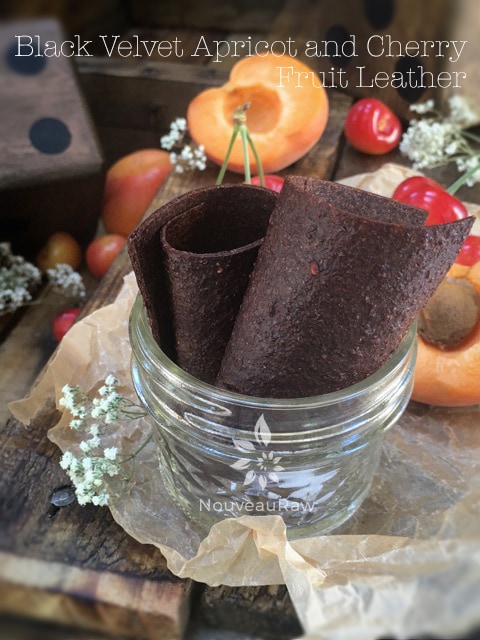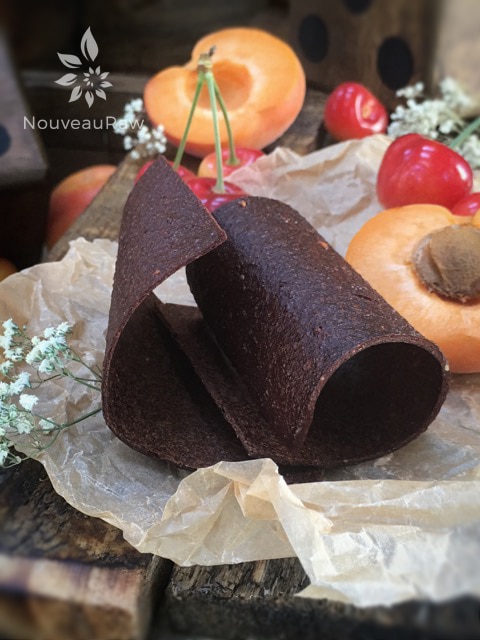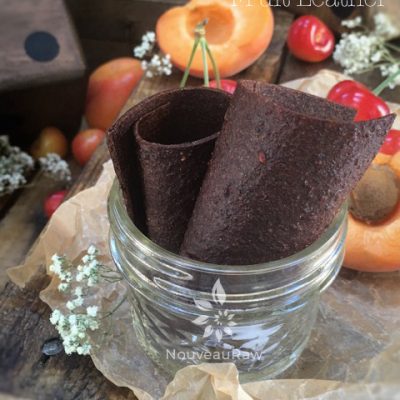Black Velvet Apricot and Cherry Fruit Leather

 Add to favorites
Add to favorites
 ~ raw, vegan, gluten-free, nut-free ~
~ raw, vegan, gluten-free, nut-free ~
I stumbled upon a new fruit! Well, new to me. I am a fruit lover and thought that I knew them all! Last week I made a pit-stop at Costco, pit-stop my derrière! No one just “pops” into Costco. It’s an event that requires endurance, large carts, and pocketbooks to match.
Thankfully, my grocery shopping habits have shifted over the years, and I no longer consume significant amounts of packaged, boxed, and processed foods.
So, that alone relieves me from filling my cart with a case of ranch dressing and gallons of tartar sauce. Lol But I do always make my way to the produce department to see if they have anything new and exciting.
And gosh, a few weeks ago I even found organic, de-stemmed kale leaves! So, it never hurts to check out what they have. Plums! They had plums, and I knew that they would pair beautifully with my cherries back home. So, I made my way to the checkout lane with only a little “cart rage” and patiently waited my turn to check out.
An elderly woman behind me commented on my fruit and asked what they were. “They are plums mam, don’t they look delicious?” She agreed. To entertain myself as I waited, I decided to read the detailed label on the fruit container… “Black Velvet Apricots”…. oh my! They are apricots! Black Velvet Apricots!
Black Velvet apricots are classified as a stone fruit alongside plums, cherries, peaches, mangoes, and even almonds. The name, Black Velvet, is a designated trade name for a natural cross hybrid between plums and apricots. The Black Velvet apricot has the initial appearance of an orb-shaped dark plum, a physical trait inherited from its plum parentage. Its skin is covered with a nearly invisible fuzz (much like my face), which gives it a smooth velvet finish (again, much like my face. lol).
The fruit’s flesh is a golden hue with tones of ruby-red where the flesh meets the skin. When ripe, the flesh is sweet forward with a bright and tangy finish. The flesh also has a soft melting quality with layers of juice that make the fruit’s consistency delicious when perfectly ripe, yet once overly mature can become mealy and less pleasant, as the fruit continues to ripen after being picked. To store, refrigerate ripe fruit only a few days, as its shelf-life is brief and quality will be compromised once harvested.
 Ingredients:
Ingredients:
- 8 cups Bing cherries, washed and pitted
- 15 Black Velvet Apricots
Preparation:
- Select RIPE or slightly overripe cherries and apricots that have reached a peak in color, texture, and flavor.
- Prepare the fruit; wash, dry, remove stems, pits, seeds, and so forth. Remove the skins of apricots if desired (I kept the skins on mine) and any bruised areas.
- Puree the fruit in your blender or food processor until smooth. Taste and sweeten if needed. Keep in mind that flavors will intensify as they dehydrate. When adding a sweetener do so 1 tbsp at a time, and reblend, tasting until it is at the desired taste. It is best to use a liquid type sweetener such as raw honey or maple syrup as an example. Don’t use granulated sugar because it tends to change the texture of the finished fruit leather.
- Problem: The puree for the fruit leather is too thick (won’t pour easily). Add fruit juice or water, a little at a time until the right consistency. Also, you can add other fruits that are higher in water content.
- Problem: The puree for the fruit leather is too thin (too runny). Mix with fruit that has a lower water content such as banana (make a thicker puree), or add 1 Tbsp at a time of ground chia seeds.
- Spread the fruit puree on teflex sheets that come with your dehydrator. Pour the puree to create an even depth of 1/8 to 1/4 inch. If you don’t have teflex sheets for the trays, you can line your trays with plastic wrap or parchment paper. Do not use wax paper or aluminum foil.
- Lightly coat the food dehydrator plastic sheets or wrap with a cooking spray, I use coconut oil that comes in a spray.
- When spreading the puree on the liner, allow about an inch of space between the mixture and the outside edge. The fruit leather mixture will spread out as it dries, so it needs a little room to allow for this expansion.
- Be sure to spread the puree evenly on your drying tray. When spreading the puree mixture, try tilting and shaking the tray to help it distribute more evenly. Also, it is a good idea to rotate your trays throughout the drying period. This will help assure that the leathers dry evenly.
- Dehydrate the fruit leather at 145 degrees (F) for one hour then reduce temp to 115 degrees for about 16 (+/-) hours. The finished consistency should be pliable and easy to roll.
- Check for dark spots on top of the fruit leather. If dark spots can be seen it is a sign that it is not completely dry.
- Press down on the fruit leather with a finger. If no indentation is visible or it is no longer tacky to the touch, the fruit leather is dry and can be removed from the dehydrator.
- Peel the leather from the dehydrator trays or parchment paper. If the fruit leather peels away easily and holds its shape after peeling, it is dry. If the fruit leather is still sticking or loses its shape after peeling, it needs further drying.
- Under-dried fruit leather will not keep; it will mold. Over-dried fruit leather will become hard and crack, although it will still be edible and will keep for a long time
- Storage: To store the finished fruit leather…
- Allow the leather to cool before wrapping up to avoid moisture from forming, thus giving it a breeding ground for molds.
- Roll them up and wrap them tightly with plastic wrap. Click (here) to see photos of how I wrap them.
- Place in an air-tight container, and store in a dry, dark place. (Light will cause the fruit leather to discolor.)
- The fruit leather will keep at room temperature for one month, or in a freezer for up to one year.
Culinary Explanations:
- Why do I start the dehydrator at 145 degrees (F)? Click (here) to learn the reason behind this.
- When working with fresh ingredients, it is important to taste test as you build a recipe. Learn why (here).
- Don’t own a dehydrator? Learn how to use your oven (here). I do however truly believe that it is a worthwhile investment. Click (here) to learn what I use.
© AmieSue.com
Tags: Dairy Free, Gluten Free, Nut Free, Refined Sugar Free, Soy Free, sugar free, Vegan



 Add to favorites
Add to favorites
 ~ raw, vegan, gluten-free, nut-free ~
~ raw, vegan, gluten-free, nut-free ~ Ingredients:
Ingredients:
I just stumbled upon your website. It is absolutely elegant; you are artistic and articulate. We have been cooking about 75% raw for a year, and I still found tutorials that are helpful. Love the look of your recipes – we’ll be trying some today!
Thank you so much!
Good afternoon Amy,
Thank you so much for taking time out of your day to share such sweet words with me. I appreciate that. We eat about 75% raw ourselves… I just love it! I hope you find some recipes here that are an inspiration to you! Blessings, amie sue